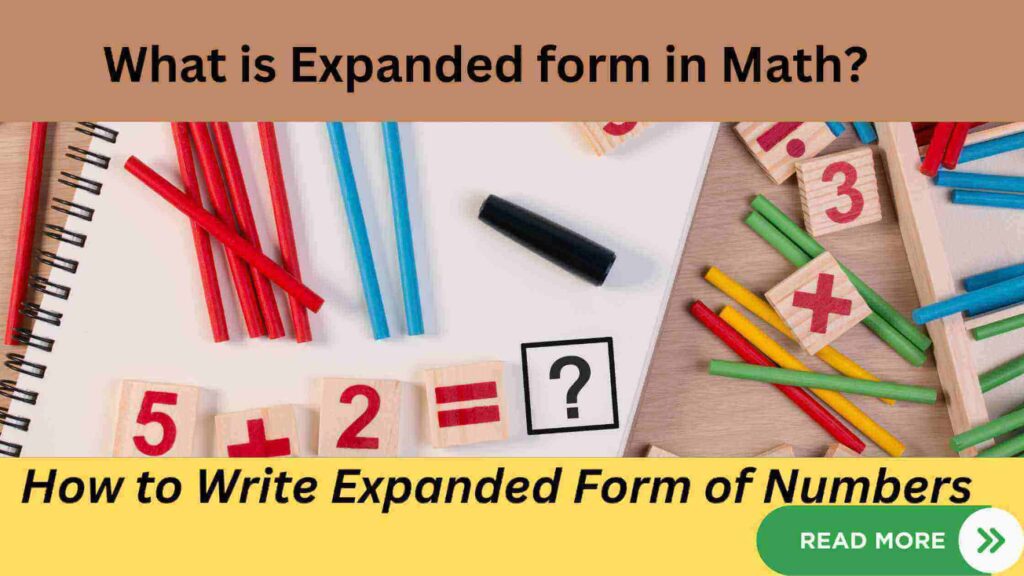Mathematics allows the expression of each digit within a number in expanded form, defined as its sum multiplied by its place value, in this article we discuss this expanded form, expanded form of decimal numbers, expanded factor form, and exponential form in more depth as examples with solved examples provided herein.
What is Expanded Form of Numbers?
The expanded form of a number unveils the significance of each digit by expressing it as the sum of the digit multiplied by its corresponding place value. Essentially, it breaks down a number into units, tens, hundreds, and thousands. For instance, the number 1572 can be vividly represented as 1000+500+70+2.
Let’s illuminate this concept further with some examples:
| Number | Ten Thousand | Thousands | Hundreds | Tens | Ones |
|---|---|---|---|---|---|
| 723 | 7 | 2 | 3 | ||
| 1243 | 1 | 2 | 4 | 3 | |
| 5679 | 5 | 6 | 7 | 9 | |
| 23456 | 2 | 3 | 4 | 5 | 6 |
Taking the number 723 as an example, it comprises 7 hundreds, 2 tens, and 3 ones.
More Insights into Expanded Form
Let’s explore additional examples to deepen our understanding:
- The expanded form of 90 is 90+0, where 9 represents tens, and there are zero ones.
- For 300, the expanded form is 300+0+0, as there are zero tens and zero ones.
- The grandeur of 10,000 unfolds as 10000+0+0+0+0, where there are zeros in the thousands, hundreds, tens, and ones places.
How to write numbers in expanded form, with examples
To craft numbers in expanded form, follow these steps:
- Obtain the standard form of the number.
- Identify the place value using a place value chart.
- Multiply each digit by its place value.
- Present the numbers as the sum of (digit × place value) to obtain the expanded form.
As an example, let’s decipher the expanded form of 35713:
- Step 1: The standard form is 35713.
- Step 2: Place values are 10,000, 1000, 100, 10, and 1.
- Step 3: Multiply each digit by its place value.
- Step 4: The expanded form is 30,000+5000+700+10+3.
Expanded Form of Decimal Numbers
Decimal numbers, too, can be unveiled in expanded form. Multiply each decimal digit by increasing exponent values of 1/10. Consider the example 83.34:
- The expanded form of 83 is 80+3.
- For 34, it’s 3(1/10) + 4(1/100), or alternatively, 0.3 + 0.04.
So, the expanded form of 83.34 is 80+3+0.3+0.04.
Expanded Factor Form
Expanded factor form involves expressing a number as the sum of the product of its digit and place value. It’s a captivating way to view standard numbers.
Expanded Factor Form = Sum of (Digit × Place value)
Expanded Exponential Form
In expanded exponential form, the powers of 10 reveal the place values of digits. For instance, the expanded exponential form of 2325 is (2 × 10^3) + (3 × 10^2) + (2 × 10^1) + (5 × 10^0).
Watch a video on Expanded Form
Do Practice of below Problems
Now, let’s test our newfound knowledge with some practice problems:
- Expand the number 98234.
- Uncover the expanded form of the decimal number 14.269.
- Express the number 4674 in exponential form.
- Unravel the exponential form of the decimal number 3.726.
- Convert the number 2.7690 into an expanded form.
Embark on this mathematical journey, and may the mysteries of expanded forms unfold effortlessly before you!
- Unseen Passage for Class 3 English with Question Answers
- Noun Worksheet for Class 2: Types and Roles in Sentence Construction
- Cordova Smart Class Software: Transformative Learning Solutions
Frequently Asked Questions on Expanded Form
[saswp_tiny_multiple_faq headline-0=”h3″ question-0=”What is expanded form in mathematics?” answer-0=”Expanded form breaks down a number into the sum of each digit multiplied by its place value, revealing its numerical composition.” image-0=”” headline-1=”h3″ question-1=”How to write numbers in expanded form?” answer-1=”Obtain the standard form, identify place values, multiply digits by place values, and sum them up to create the expanded form.” image-1=”” headline-2=”h3″ question-2=”Can decimal numbers have an expanded form?” answer-2=”Yes, decimal numbers can be expressed in expanded form by multiplying each digit by increasing exponent values of 1/10.” image-2=”” headline-3=”h3″ question-3=”What is expanded factor form?” answer-3=”Expanded factor form expresses a number as the sum of the product of each digit and its place value, offering a unique perspective.” image-3=”” headline-4=”h3″ question-4=”Explain expanded exponential form.” answer-4=”Expanded exponential form represents the place values of digits using powers of 10, providing insight into the structure of a number.” image-4=”” count=”5″ html=”true”]
